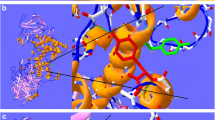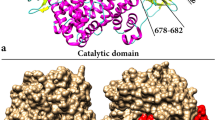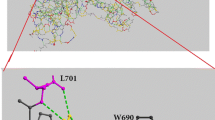Abstract
Immune response stimulation and inactivation of chondroitinase ABC I in physiological condition have been limited its use in various clinical conditions as a bacterial enzyme drug. In the present study, we have investigated some structural and functional features of N∆89, C∆274 and N∆89C∆274; three designed truncated cABC I, in order to clarify the unclear role of two terminal parts of cABC I i.e., the 1–89 and 747–1021 amino acids sequences of the full length enzyme through truncation. As a result, the numbers of potential epitopes, the susceptibility to trypsin digestion, ANS fluorescence spectra, and fluorescence quenching using KI and acrylamide were diminished for N∆89 and C∆274 in comparison to the wild type. Secondary and tertiary structure investigation for N∆89 and C∆274 revealed that the intrinsic fluorescence was increased and Far-UV CD spectra were changed accordingly. Relative to the wild type enzyme, 0.164, 0.195 remaining activity and lack of activity was shown with the zymographic assay for N∆89, C∆274 and N∆89C∆274 variants, respectively. The diminished enzyme activity and structural changes suggested a reorientation of microenvironments interactions including cation–π interactions around structural elements toward lowering regional mobility. Constructing applicable truncated cABC I with improved features could be regarded as a strategy to regain new possible functional advantages over the full length enzyme.










Similar content being viewed by others
Abbreviations
- cABC I:
-
Chondroitinase ABC I
- cAC:
-
Chondroitinase AC
- PIC:
-
Protein interaction calculator
- LB:
-
Luria–Bertani
- IPTG:
-
Isopropyl-ß-d-thiogalactopyranoside
- PMSF:
-
Phenylmethanesulfonyl fluoride
- DAB:
-
3,3′-Diaminobenzidine
- SDS-PAGE:
-
Sodium dodecyl sulfate-polyacrylamide gel electrophoresis
- ANS:
-
8-Anilinonaphthalene-1-sulfonic acid
References
Bradbury EJ, Moon LD, Popat RJ, King VR, Bennett GS, Patel PN, Fawcett JW, McMahon SB (2002) Chondroitinase ABC promotes functional recovery after spinal cord injury. Nature 416(6881):636–640
Kasinathan N, Volety SM, Josyula VR (2016) Chondroitinase: a promising therapeutic enzyme. Crit Rev Microbiol 42(3):474–484
Pizzorusso T, Medini P, Berardi N, Chierzi S, Fawcett JW, Maffei L (2002) Reactivation of ocular dominance plasticity in the adult visual cortex. Science 298(5596):1248–1251
Denholm EM, Lin Y-Q, Silver PJ (2001) Anti-tumor activities of chondroitinase AC and chondroitinase B: inhibition of angiogenesis, proliferation and invasion. Eur J Pharmacol 416(3):213–221
Tester NJ, Plaas AH, Howland DR (2007) Effect of body temperature on chondroitinase ABC’s ability to cleave chondroitin sulfate glycosaminoglycans. J Neurosci Res 85(5):1110–1118
Maleki M, Khajeh K, Amanlou M, Golestani A (2017) Role of His-His interaction in Ser 474-His 475-Tyr 476 sequence of chondroitinase ABC I in the enzyme activity and stability. Int J Biol Macromol. https://doi.org/10.1016/j.ijbiomac.2017.11.075
Nazari-Robati M, Khajeh K, Aminian M, Fathi-Roudsari M, Golestani A (2012) Co-solvent mediated thermal stabilization of chondroitinase ABC I form Proteus vulgaris. Int J Biol Macromol 50(3):487–492
Nazari-Robati M, Khajeh K, Aminian M, Mollania N, Golestani A (2013) Enhancement of thermal stability of chondroitinase ABC i by site-directed mutagenesis: an insight from Ramachandran plot. Biochim Biophys Acta (BBA)-Proteins Proteom 1834(2):479–486
Shahaboddin ME, Khajeh K, Maleki M, Golestani A (2017) Improvement of activity and stability of Chondroitinase ABC I by introducing an aromatic cluster at the surface of protein. Enzyme Microb Technol 105:38–44
Shirdel SA, Khalifeh K, Golestani A, Ranjbar B, Khajeh K (2015) Critical role of a loop at C-terminal domain on the conformational stability and catalytic efficiency of chondroitinase ABC I. Mol Biotechnol 57(8):727–734
Pakulska MM, Vulic K, Shoichet MS (2013) Affinity-based release of chondroitinase ABC from a modified methylcellulose hydrogel. J Controlled Release 171(1):11–16
Shahaboddin ME, Khajeh K, Golestani A (2018) Establishment of aromatic pairs at the surface of chondroitinase ABC I: the effect on activity and stability. Appl Biochem Biotechnol 186(2):358–370
Bagherieh M, Kheirollahi A, Shahaboddin ME, Khajeh K, Golestani A (2017) Calcium and TNFα additively affect the chondroitinase ABC I activity. Int J Biol Macromol 103:1201–1206
Thompson MJ, Eisenberg D (1999) Transproteomic evidence of a loop-deletion mechanism for enhancing protein thermostability. J Mol Biol 290(2):595–604
Gruskin EA, D’souza R, Roy G, Caggiano AO (2016) Proteoglycan degrading mutants for treatment of CNS. Google Patents
De Groot AS, Scott DW (2007) Immunogenicity of protein therapeutics. Trends Immunol 28(11):482–490
Onda M (2009) Reducing the immunogenicity of protein therapeutics. Curr Drug Targets 10(2):131–139
Huang W, Boju L, Tkalec L, Su H, Yang H-O, Gunay NS, Linhardt RJ, Kim YS, Matte A, Cygler M (2001) Active site of chondroitin AC lyase revealed by the structure of enzyme–oligosaccharide complexes and mutagenesis. Biochemistry 40(8):2359–2372
Hamai A, Hashimoto N, Mochizuki H, Kato F, Makiguchi Y, Horie K, Suzuki S (1997) Two distinct chondroitin sulfate ABC lyases an endoeliminase yielding tetrasaccharides and an exoeliminase preferentially acting on oligosaccharides. J Biol Chem 272(14):9123–9130
Huang W, Lunin V, Li Y, Suzuki S, Sugiura N, Miyazono H, Cygler M (2003) Crystal structure of Proteus vulgaris chondroitin sulfate ABC lyase I at 1.9 Å resolution. J Mol Biol 328(3):623–634
Shaya D, Hahn B-S, Bjerkan TM, Kim WS, Park NY, Sim J-S, Kim Y-S, Cygler M (2008) Composite active site of chondroitin lyase ABC accepting both epimers of uronic acid. Glycobiology 18(3):270–277
Chen Z, Li Y, Feng Y, Chen L, Yuan Q (2015) Enzyme activity enhancement of chondroitinase ABC I from Proteus vulgaris by site-directed mutagenesis. RSC Adv 5(93):76040–76047
Dmitrieva N, Yu L, Viapiano M, Cripe TP, Chiocca EA, Glorioso JC, Kaur B (2011) Chondroitinase ABC I–mediated enhancement of oncolytic virus spread and antitumor efficacy. Clin Cancer Res 17(6):1362–1372
Mohammadi M, Sepehrizadeh Z, Ebrahim-Habibi A, Shahverdi AR, Faramarzi MA, Setayesh N (2015) Bacterial expression and characterization of an active recombinant lipase A from Serratia marcescens with truncated C-terminal region. J Mol Catal B 120:84–92
Prabhakar V, Capila I, Carlos J, Pojasek K, Sasisekharan R (2005) Chondroitinase ABC I from Proteus vulgaris: cloning, recombinant expression and active site identification. Biochem J 386(1):103–112
Prabhakar V, Capila I, Raman R, Bosques C, Pojasek K, Sasisekharan R (2012) Chondroitinase ABC I and methods of degrading therewith. Google Patents
Prabhakar V, Raman R, Capila I, Bosques CJ, Pojasek K, Sasisekharan R (2005) Biochemical characterization of the chondroitinase ABC I active site. Biochem J 390(2):395–405
Asad S, Dabirmanesh B, Ghaemi N, Etezad SM, Khajeh K (2013) Studies on the refolding process of recombinant horseradish peroxidase. Mol Biotechnol 54(2):484–492
Miura RO, Yamagata S, Miura Y, Harada T, Yamagata T (1995) Analysis of glycosaminoglycan-degrading enzymes by substrate gel electrophoresis (zymography). Anal Biochem 225(2):333–340
Vandooren J, Geurts N, Martens E, Van den Steen PE, Opdenakker G (2013) Zymography methods for visualizing hydrolytic enzymes. Nat Methods 10(3):211–220
Böhm G, Muhr R, Jaenicke R (1992) Quantitative analysis of protein far UV circular dichroism spectra by neural networks. Protein Eng Des Sel 5(3):191–195
Gasymov OK, Glasgow BJ (2007) ANS fluorescence: potential to augment the identification of the external binding sites of proteins. Biochim Biophys Acta (BBA)-Proteins Proteom 1774(3):403–411
Gandorfer A (2008) Enzymatic vitreous disruption. Eye 22(10):1273–1277
Arjomand MR, Habibi-Rezaei M, Ahmadian G, Hassanzadeh M, Karkhane AA, Asadifar M, Amanlou M (2016) Deletion of loop fragment adjacent to active site diminishes the stability and activity of exo-inulinase. Int J Biol Macromol 92:1234–1241
Chi M-C, Chen Y-H, Wu T-J, Lo H-F, Lin L-L (2010) Engineering of a truncated α-amylase of Bacillus sp. strain TS-23 for the simultaneous improvement of thermal and oxidative stabilities. J Biosci Bioeng 109(6):531–538
Hai T, Lee J-S, Kim T-J, Suh J-W (2009) The role of the C-terminal region of cyanophycin synthetase from Nostoc ellipsosporum NE1 in its enzymatic activity and thermostability: a key function of Glu 856. Biochim Biophys Acta (BBA)-Proteins Proteom 1794 (1):42–49
Kim Y-M, Shimizu R, Nakai H, Mori H, Okuyama M, Kang M-S, Fujimoto Z, Funane K, Kim D, Kimura A (2011) Truncation of N-and C-terminal regions of Streptococcus mutans dextranase enhances catalytic activity. Appl Microbiol Biotechnol 91(2):329–339
Miyamura N, Araki E, Matsuda K, Yoshimura R, Furukawa N, Tsuruzoe K, Shirotani T, Kishikawa H, Yamaguchi K, Shichiri M (1996) A carboxy-terminal truncation of human alpha-galactosidase A in a heterozygous female with Fabry disease and modification of the enzymatic activity by the carboxy-terminal domain. Increased, reduced, or absent enzyme activity depending on number of amino acid residues deleted. J Clin Investig 98(8):1809
Valušová E, Sedlák E, Antalík M, Nock S, Sprinzl M (2001) Effect of N-domain on the stability of elongation factor Ts from Thermus thermophilus. Biochim Biophys Acta (BBA)-Protein Struct Mol Enzymol 1547 (1):117–126
Vihinen M, Peltonen T, Iitiä A, Suominen I, Mäntsälä P (1994) C-terminal truncations of a thermostable Bacillus stearothermophilus α-amylase. Protein Eng Des Sel 7(10):1255–1259
Hawe A, Sutter M, Jiskoot W (2008) Extrinsic fluorescent dyes as tools for protein characterization. Pharm Res 25(7):1487–1499
Fontana A, de Laureto PP, De Filippis V, Scaramella E, Zambonin M (1997) Probing the partly folded states of proteins by limited proteolysis. Fold Des 2(2):R17–R26
Hubbard SJ (1998) The structural aspects of limited proteolysis of native proteins. Biochim Biophys Acta (BBA)-Protein Struct Mol Enzymol 1382(2):191–206
Eftink MR, Ghiron C (1976) Exposure of tryptophanyl residues in proteins. Quantitative determination by fluorescence quenching studies. Biochemistry 15(3):672–680
Phillips S, Wilson L, Borkman R (1986) Acrylamide and iodide fluorescence quenching as a structural probe of tryptophan microenvironment in bovine lens crystallins. Curr Eye Res 5(8):611–620
Crowley PB, Golovin A (2005) Cation–π interactions in protein–protein interfaces. Proteins: Struct Funct Bioinform 59(2):231–239
Gallivan JP, Dougherty DA (1999) Cation-π interactions in structural biology. Proc Natl Acad Sci 96(17):9459–9464
Marcelino AMC, Gierasch LM (2008) Roles of β-turns in protein folding: from peptide models to protein engineering. Biopolymers 89(5):380–391
Fields PA (2001) Protein function at thermal extremes: balancing stability and flexibility. Comp Biochem Physiol A 129(2–3):417–431
Gutteridge A (2005) Understanding the relationship between enzyme structure and catalysis. University of Cambridge
Acknowledgements
Financial support for this work was provided by Research Council of Tehran University of Medical Sciences under Contract Number of 29977.
Author information
Authors and Affiliations
Corresponding authors
Ethics declarations
Conflict of interest
The authors declare that they have no conflicts of interest.
Research Involving Human and Animal Participants
This article does not contain any studies with human participants or animals performed by any of the authors.
Additional information
Publisher’s Note
Springer Nature remains neutral with regard to jurisdictional claims in published maps and institutional affiliations.
Rights and permissions
About this article
Cite this article
Omidi-Ardali, H., Aminian, M., Golestani, A. et al. N∆89 and C∆274 Truncated Enzymes of Chondroitinase ABC I Regain More Imperturbable Microenvironments Around Structural Components in Comparison to their Wild Type. Protein J 38, 151–159 (2019). https://doi.org/10.1007/s10930-019-09821-y
Published:
Issue Date:
DOI: https://doi.org/10.1007/s10930-019-09821-y




